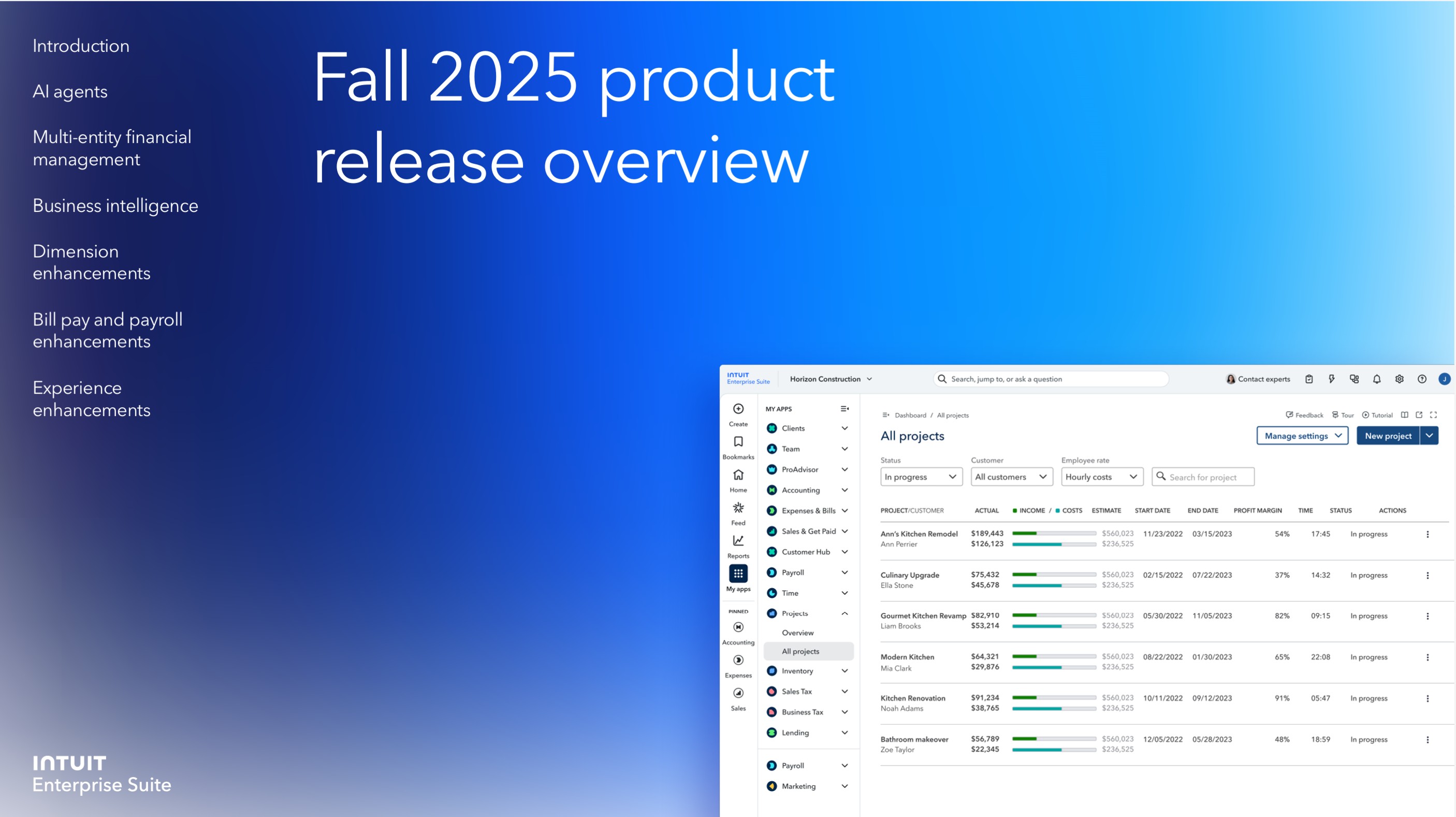
Managing construction accounting means keeping up with constant change in projects, people, and technology. Intuit Enterprise Suite’s Fall 2025 release adds a new layer of AI, multi-entity controls, and reporting tools that make it easier to run a construction company on one connected platform. Check out all IES features in the The Complete Guide to (IES) Intuit Enterprise Suite for Construction Companies
Featured Answer
Intuit Enterprise Suite’s Fall 2025 release delivers new AI agents, multi-entity controls, business intelligence dashboards, and bill pay/payroll enhancements that help construction companies improve job costing, speed up month-end close, and manage multi-entity structures with less manual work. Many of the most powerful features, including consolidated KPIs and the new navigation experience, require a one-time platform transition for existing IES customers.
Intuit Enterprise Suite Fall 2025 Release: Why It Matters for Construction
Construction companies are dealing with more entities, more projects, and more data than ever. You have equipment entities, development entities, operating entities, and JV structures layered on top of complex job costing, WIP, and retention.
The Fall 2025 release of Intuit Enterprise Suite (IES) focuses on four big themes that matter directly to contractors:
- AI agents that push routine work off your plate
- Multi-entity tools that reduce intercompany chaos
- Business intelligence that actually explains your numbers
- Bill pay, payroll, and navigation updates that make the system easier to live in every day
If you looked at IES earlier in the year, this release is worth another look. It turns a strong product into a more complete mid-market platform for construction companies in roughly the $7M–$250M revenue band.
TL;DR
- New and enhanced AI agents handle customer leads, payroll data collection, accounting cleanup, cash flow, payments, and project management.
- Multi-entity hub adds a consolidated view, deeper reporting, intercompany expense allocations, and dynamic allocations at the account level.
- Business intelligence Suite brings styled reports, KPI scorecards, dashboards, and management report packages into one place.
- Dimension enhancements let you bulk-apply dimensions via Spreadsheet Sync and use AI to recommend dimension values.
- Bill pay and payroll upgrades add payment release approvals, instant bill payments, better W-2 handling, faster payroll, and smoother paycheck corrections.
- Experience enhancements introduce a modern UI, guided onboarding, customer and vendor data upgrades, and a one-time transition process required for some features.
AI Agents: Turning Daily Chaos into Managed Workflows
Intuit continues to build out its AI “agent” strategy. In Fall 2025, several new agents arrive and existing ones get smarter. For construction companies, these agents matter because they automate the low-value work that usually eats your accounting team’s day.
Customer Agent: Turning Email into Pipeline

The new Customer Agent scans your Gmail inbox for leads, drafts personalized responses, and tracks those opportunities through your sales cycle. It spots buying signals, suggests next steps (like scheduling a walkthrough or sending an estimate), and keeps everything in a simple sales view.
Construction angle:
- Capture bid requests and RFQs that would otherwise get buried in email
- Keep track of which GCs, developers, or owners are active without juggling spreadsheets
- Let the agent draft follow-ups so your team can focus on scoping and pricing
Payroll Agent: Collecting Time So You Don’t Have To
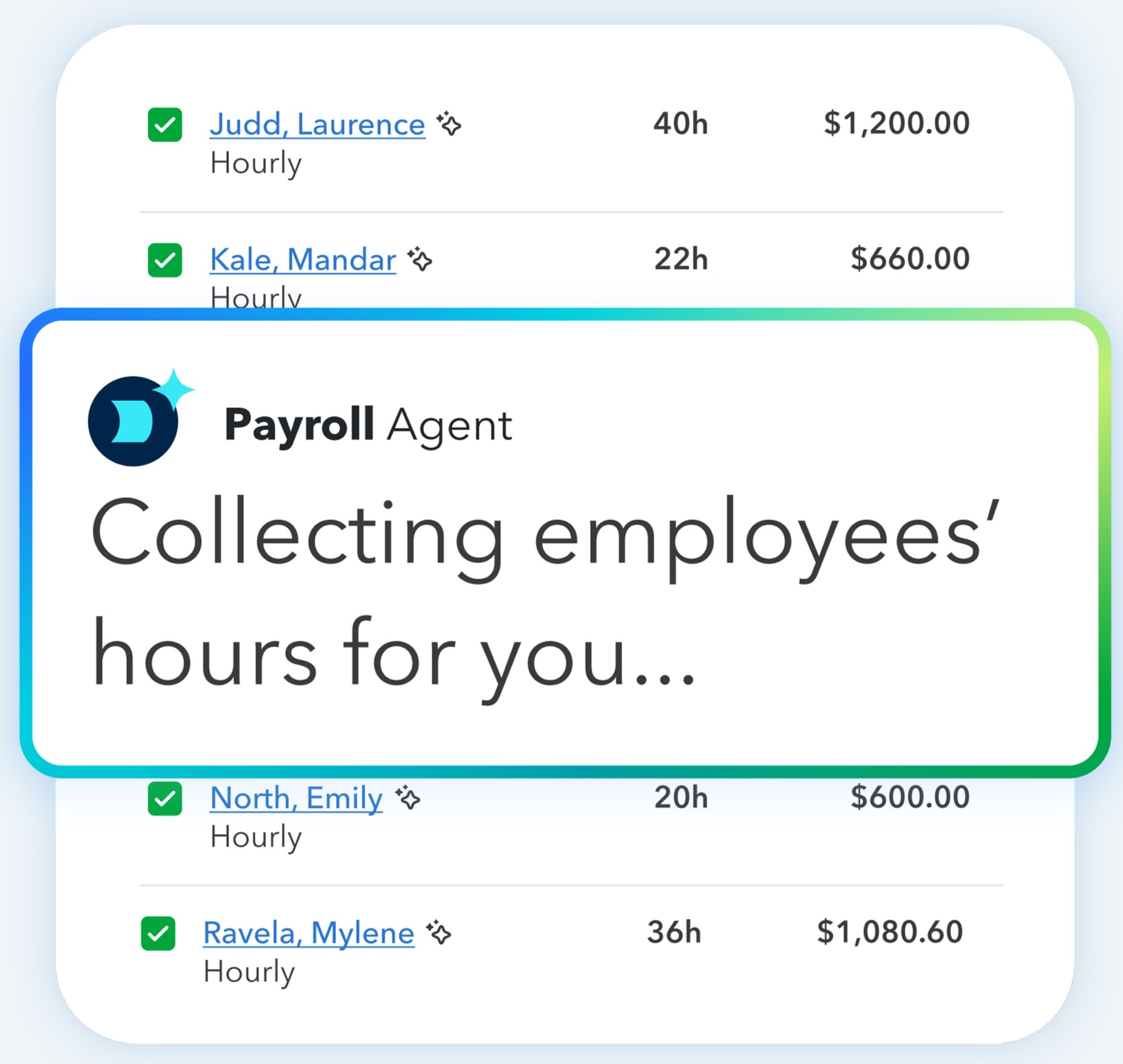
The Payroll Agent builds a payroll data collection plan for your company, messages employees via text or the Workforce app, and collects hours, tips, and other data directly from the field. It then pre-loads that data into a payroll draft and flags anomalies for review.
For contractors:
- Better time capture for crews across multiple jobs and locations
- Less manual keying of hours and fewer payroll surprises
- A cleaner foundation for labor-based job costing
Accounting Agent: Cleaner Books with Less Effort
The Accounting Agent now extracts transactions from PDF statements, compares them to IES data, highlights errors, and proposes fixes. It can also flag transactions it is highly confident about so you can one-click post them. A refreshed banking grid gives you inline editing, AI suggestions, and clear explanations for categorizations.
Why that matters in construction:
- Faster, cleaner bank and credit card reconciliations across entities
- Better control over mis-coded materials, subs, and equipment expenses
- Reduced risk of missing or duplicated transactions during busy months
Finance Agent Enhancment: Smarter Month-End Close
The Finance Agent generates a monthly performance summary and now supports:
- Custom time periods (month, quarter, year)
- Editable AI-generated commentary
- PDF exports of summaries
- “Next action” recommendations and ranked KPI variances
- Deeper chat queries down to transaction and dimension level
For construction, this becomes your monthly management package in one place, with enough context to explain why margins moved, where expenses spiked, and which entities or projects need attention.

Payments Agent Enhancment: Faster, Smarter Invoicing
The Payments Agent reads lead content in Gmail to autofill estimates and can now proactively draft recurring invoices. It suggests likely matches between payments and customers so your AR stays cleaner.
Think:
- Progress invoices that go out on time
- Fewer missed recurring billings for maintenance, T&M work, or service contracts
- Less time matching deposits to jobs
Project Management Agent Enhancment: From Contract to Closeout
The Project Management Agent gets several construction-friendly improvements:
- Convert signed contracts in Customer Hub directly into projects
- Automatically populate phases from uploaded documents
- Recommend project cost allocations and explain the logic
- Create project budgets from spreadsheets or estimates
- Provide closing summaries that explain estimate vs actual variances and key drivers
For GCs and subs, this is where IES starts to feel like a true project accounting system, not just a general ledger with jobs bolted on.
Multi-Entity Financial Management: Designed for Growing Contractors
Many construction firms are already living in a multi-entity world. The Fall 2025 release significantly improves how you see and manage those entities in IES.
Note: Access to many of these capabilities requires a one-time transition that Intuit runs overnight.
Consolidated View: One Landing Page for All Entities

The new consolidated view gives your team a single entry point to see financials across every entity they have permissions for. Non-admin roles can now:
- Run consolidated reports
- Work on intercompany tasks
- Manage shared chart of accounts
- Configure elimination accounts and perform manual eliminations
This is ideal for controllers, bookkeepers, and AP managers who need to get work done without relying on an administrator for every change.
Multi-Entity Reporting Enhancements
Consolidated reporting now supports deeper drill-down and better intercompany visibility:
- Drill into consolidated reports without requiring a shared COA
- See intercompany transactions from child entities with dimensions, projects, and customers
- Quickly spot intercompany entries labeled with “(IC)”
- Grant broader access to consolidated reports via the consolidated view
This makes it easier to explain results to banks, sureties, and ownership without exporting data into external tools.
Intercompany Expense Allocations
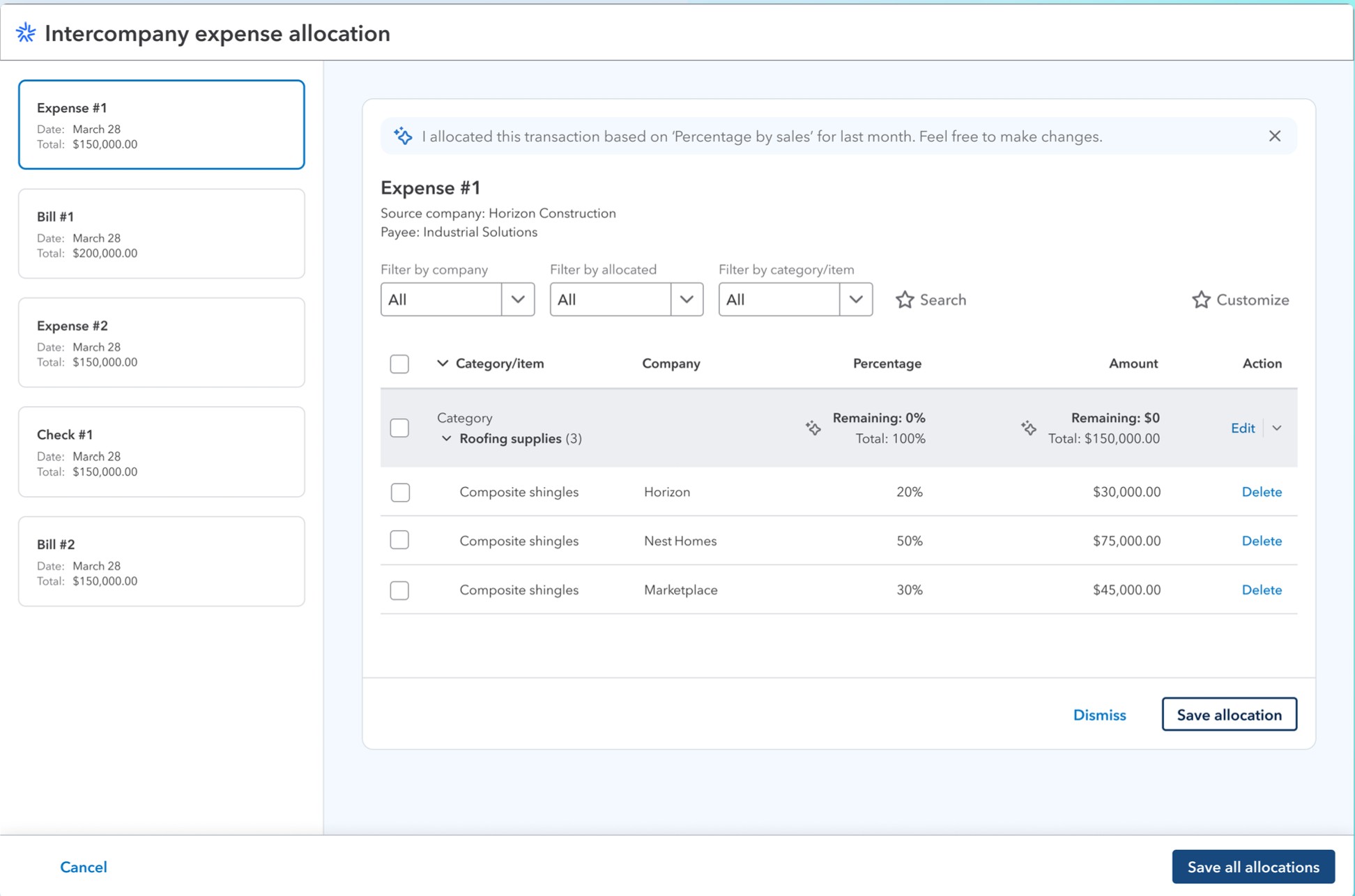
Intercompany allocations now cover more transaction types and account categories, including refunds, assets, liabilities, and revenue. You also get:
- Filters for allocated vs unallocated transactions
- Reference numbers and dates for easier tracking
- Auto-attachment of documents across entities
- The ability to delete intercompany entries and related eliminations
For contractors, this is especially useful for spreading insurance, bonding, and shared overhead across entities in a controlled way.
Dynamic Allocations: Allocate Balances in One Move
Dynamic allocations let you allocate entire account balances across entities in one step instead of transaction by transaction. You can filter by customer, vendor, employee, class, location, or dimension to shape how the allocation works.
This matters for:
- Allocating corporate overhead across operating entities
- Spreading shared equipment or yard costs across jobs
- Speeding up month-end by shifting work from transactions to accounts
Business Intelligence: Reports, KPIs, Dashboards, and Management Packs
Business intelligence is where the Fall 2025 release really starts to feel like an FP&A stack inside IES instead of a bolt-on.
Enhanced Reporting
Standard and custom reports can now be styled inside IES with:
- Highlights and banded rows
- Gridlines and variance arrows
- Global formatting settings
This lets you deliver board-ready reports without exporting to Excel every month.
KPI Scorecard
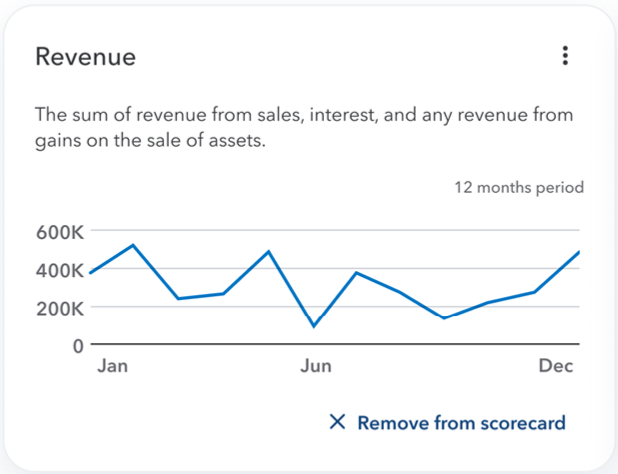
The KPI scorecard gives you a centralized library of nearly 100 predefined KPIs plus the ability to define your own. Many KPIs can be tracked at a consolidated level once you complete the transition process.
For construction, you can build scorecards around:
- Gross margin by project type or division
- WIP and backlog metrics
- DSO and retention aging
- Revenue per PM, superintendent, or crew
Dashboards
Dashboards provide one view of your most important metrics. Start with prebuilt Profitability or Cash Flow dashboards, then drag and drop charts, KPIs, tables, and narrative text blocks. AI can summarize trends in plain language, and multi-entity support allows both entity-level and consolidated views.

Management Reports
Management reports combine financials, KPIs, charts, and written insights into a polished package with cover page, branding, and executive summary. Consolidated reporting support is included for customers that complete the one-time transition.
For many contractors, this can replace separate board decks, helping you deliver consistent reporting to banks, bonding companies, and investors directly from IES.
Dimension Enhancements: Cleaner Data, Better Reporting
Dimensions are at the core of construction reporting in IES. Fall 2025 makes them easier to apply at scale and less dependent on manual setup.
Dimensions on Spreadsheet Sync
Spreadsheet Sync now supports creating and updating dimension values for multiple transactions at once, including:
- Journal entries
- Invoices and bills
- Credit memos and vendor credits
- Expenses, sales receipts, estimates, and purchase orders
That means your team can fix dimension gaps across dozens or hundreds of transactions in Excel and push updates back into IES in one move.

AI-Powered Dimension Recommendations
IES now recommends dimension values for products, services, and fixed assets that do not already have defaults. You can see the suggested dimensions, read an explanation, override them if needed, and confirm. Once saved, those dimensions prefill when those items are used in transactions.
This is especially useful for:
- Ensuring consistent division, department, or region tagging
- Reducing errors in project and cost code assignments
- Shortening the time to “trustworthy” multi-dimensional reporting
Bill Pay and Payroll Enhancements: Controls and Speed in One Place
Bill pay and payroll both get meaningful upgrades that help with controls, vendor relationships, and year-end workload.
Bill Payment Release Approvals
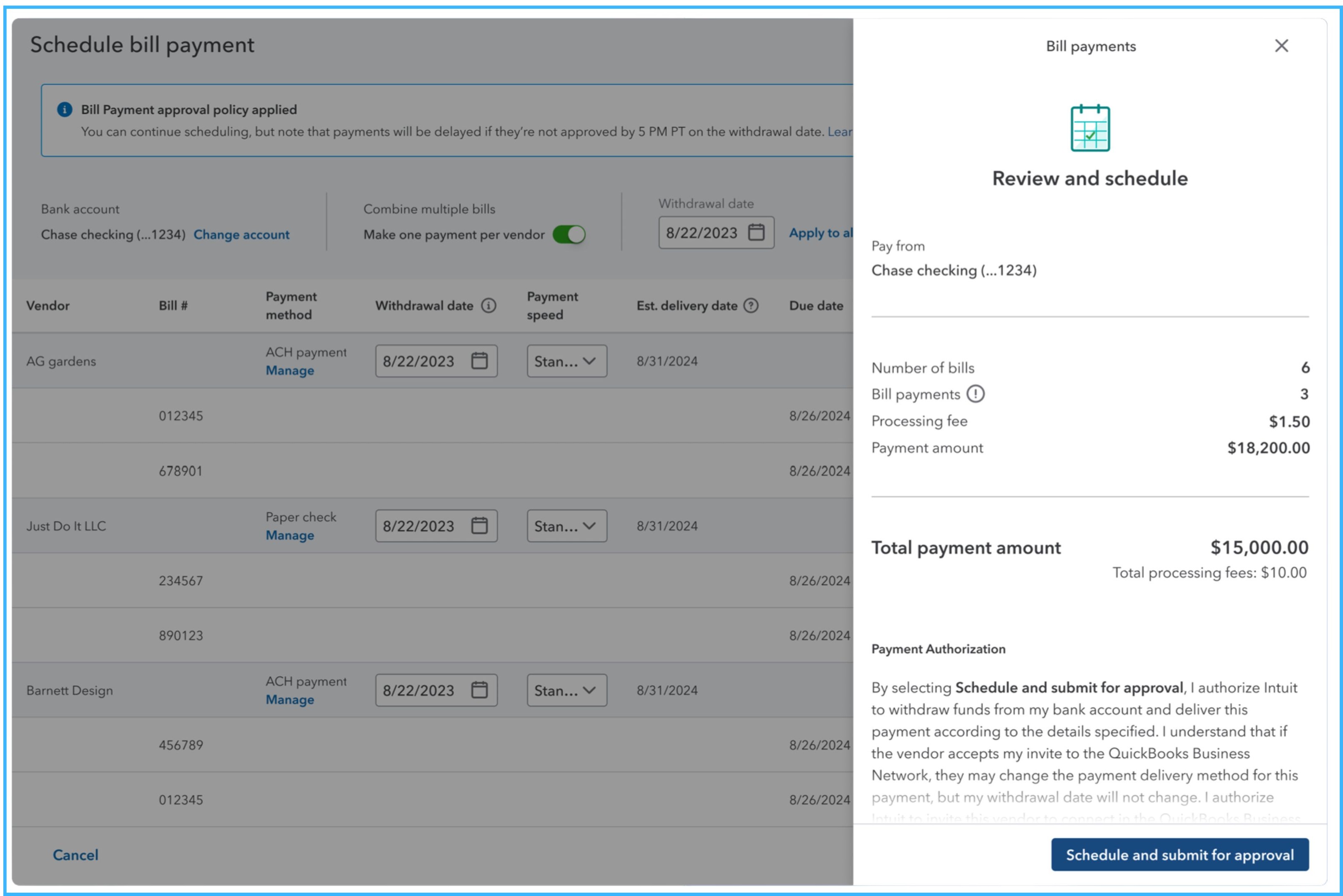
You can now add a final “release” approval step for payments. IES lets you:
- Designate a payment approver similar to a check signer
- Build rules based on amount, vendor, payment method, or scheduler
- Lock bill balances while payments wait for approval
- Prevent posting journal entries until payment is approved
For construction, this creates a clean separation between AP entry and cash movement, which helps with internal controls and cash flow.
Instant Bill Payments
In addition to ACH and checks, you can now send “instant payments” to eligible vendors within minutes for a 1 percent fee (with minimum and maximum caps).
This is valuable when:
- You need to release a critical vendor payment to keep a project moving
- You want to negotiate discounts for “paid today” terms
- You are managing tight cash windows and want precise timing
W-2 Scalability and Run Payroll Improvements
Larger firms can now load, view, and print W-2 PDFs for 100+ employees without timeouts. Payroll runs have been optimized for companies up to 200 employees, reducing lag when loading employee lists and processing runs.
Paycheck Corrections
Paycheck corrections are now consolidated into a single ticket, which improves tracking and reduces latency. If you submit multiple corrections, they all roll into one case.
Combined, these updates make payroll less stressful at year-end and more scalable as your field headcount grows.
Experience Enhancements and One-Time Transition
The platform also gets a visual and usability refresh designed to make IES feel more like a modern, integrated enterprise system.
New Navigation and Visual Updates
IES now includes:
- A modern UI with updated visuals
- Navigation organized into logical “apps” aligned with workflows
- Guided tours for new users
- Bookmarks, pinned apps, and widget selection for home pages
- A unified Tasks panel for setup and ongoing tasks in one place
Customer and Vendor Data Enhancements
For customers and vendors, the Fall 2025 update adds:
- Multiple shipping addresses per customer with defaults
- Multiple email contacts and CC/BCC options per vendor
- Notes with multiple comments and favorites for key details
These matter in construction where ship-to addresses, jobsite contacts, and vendor communication can easily get messy.
One-Time Transition Process
To get the consolidated view, new navigation, and expanded multi-entity capabilities, existing customers must complete a one-time transition that typically runs overnight. During the transition, you can still access each company individually but multi-entity features are paused. You can schedule the transition through January 31, 2026, after which Intuit will transition remaining customers automatically.

How RedHammer Can Help with the Fall 2025 IES Release
RedHammer lives at the intersection of construction accounting and enterprise software. Here is how we help contractors use these new IES capabilities effectively:
- Multi-Entity and Intercompany Design: We architect entity structures, intercompany mappings, elimination accounts, and allocation rules so the new consolidated view, dynamic allocations, and reporting match how your business runs.
- AI Agent Strategy and Setup: We configure Accounting, Finance, Payroll, Payments, Customer, and Project Management Agents for construction workflows, then tune their behavior based on real project data.
- Dimensions, Cost Codes, and Spreadsheet Sync: We design dimension frameworks and cost code structures that support job costing, WIP, and consolidation, then use Spreadsheet Sync to clean up historical transactions.
- Business Intelligence, KPIs, and Management Packs: We build dashboards, KPI scorecards, and management report packages focused on the metrics your owners, banks, and sureties care about most.
- Bill Pay and Payroll Controls: We help design bill payment approval flows, instant payment policies, and payroll processes that fit both operational reality and internal control requirements.
- Transition Planning and Change Management: We manage the one-time transition scheduling, training plans, and rollout so your team can adopt the new experience without losing momentum on live jobs.
If you are evaluating IES or already running it and want to take advantage of the Fall 2025 features, RedHammer can meet you where you are and help you get to a stable, construction-ready setup. Check out our Intuit Enterprise Suite Implementation Services
Frequently Asked Questions
Q. Do I have to complete the one-time transition to get value from Fall 2025?
A: You can benefit from some AI agents and process improvements without the transition, but the consolidated view, many multi-entity enhancements, and parts of the business intelligence suite require it. Intuit currently allows you to schedule the transition through January 31, 2026.
Q. Is IES with these updates still a good fit for $4M–$15M contractors?
A: Yes, especially if you already juggle multiple entities, projects, and bank relationships. Smaller contractors that are not doing job costing or multi-entity work may still be better served by QBO, but once you are serious about WIP, consolidation, and AI, IES becomes a strong fit.
Q. Which Fall 2025 features should construction companies turn on first?
A; Most contractors will see the fastest ROI from Accounting and Finance Agents, improved multi-entity reporting, Spreadsheet Sync for dimensions, and bill payment release approvals. These features reduce manual work and improve data quality without forcing big behavior changes in the field.
Q. How do AI dimension recommendations affect my job costing?
A: AI suggestions do not overwrite your rules. They propose dimension values like division, department, or region with explanations. You review, adjust if needed, and confirm. Once confirmed, those defaults prefill future transactions, which improves consistency and makes job costing and WIP reporting more reliable.
Q. Can IES handle our growth in headcount and entities over the next few years?
A: The Fall 2025 release specifically improves scalability for payroll up to roughly 200 employees, multi-entity reporting, and large-volume W-2 processing, along with better intercompany allocations and dynamic allocations. Taken together, those improvements support a multi-entity, multi-division contractor planning to grow beyond its current size.
Related RedHammer Content
Intuit Enterprise Suite Summer 2025 Updates: What Construction Companies Need to Know
The Complete Guide to (IES) Intuit Enterprise Suite for Construction Companies
Intuit Enterprise Suite Implementation Services









